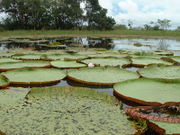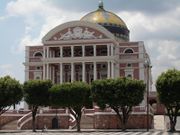Amazonas (Brazilian state)
| State of Amazonas | |||
|---|---|---|---|
| — State — | |||
|
|||
 |
|||
| Coordinates: | |||
| Country | |||
| Capital and Largest City | Manaus | ||
| Government | |||
| - Governor | Carlos Eduardo de Souza Braga | ||
| - Vice Governor | Omar José Abdel Aziz | ||
| Area | |||
| - Total | 1,570,745.7 km2 (606,468.3 sq mi) | ||
| Area rank | 1st | ||
| Population (2005 census) | |||
| - Total | 3,262,741 | ||
| - Estimate (2006) | 3,311,026 | ||
| - Rank | 15th | ||
| - Density | 2.1/km2 (5.4/sq mi) | ||
| - Density rank | 26th | ||
| Demonym | Amazonense | ||
| Time zone | UTC-4 (UTC-03) | ||
| - Summer (DST) | Brasília Summer (UTC-02) | ||
| ISO 3166 code | BR-AM | ||
| GDP | R$ 39,166,000,000 (2006 estimate) | ||
| - Rank | 14th | ||
| - Per capita | R$ 11,829 | ||
| - Per capita rank | 9th | ||
| HDI | 0.780 (2005) | ||
| - Category | medium | ||
| - Rank | 12th | ||
| Website | amazonas.am.gov.br | ||
Amazonas Portuguese pronunciation: [amaˈzõnɐs][1]) is a state of Brazil, located in the northwestern corner of the country. Neighboring states are (from north clockwise) Roraima, Pará, Mato Grosso, Rondônia, and Acre. It also borders Peru, Colombia and Venezuela. This includes the department Amazonas in Colombia, as well as the Amazonas State, Venezuela (it does not border the Peruvian Amazonas Region). The prime feature of Amazonas is its immense forest. This is the largest Brazilian State in area, with 1.57 million square kilometers. From the capital, Manaus, one can take tours to see the meeting of waters, where the rivers Negro and Solimões run alongside without mixing their waters, and stay in the lodges in the forest. Though far from the ocean, Manaus is a port city. Among its many attractions are the Teatro Amazonas, the Municipal Market, the Zoo, the Forest of Science, and the Museum of the Indian. Outside Manaus, aside from the meeting of the waters, the main attractions are tours of the largest biodiversity on the planet, with a fauna of more than 250 species of mammals, 2,000 types of fish and 1,100 types of birds.
Contents |
Geography

Amazonas is named after the Amazon River, and home to the highest mountain in Brazil, Pico da Neblina, a tepui which stands at 2,994 meters above sea level. The state is almost entirely covered by the Amazon Rainforest, 98% according to officials,[2] and it is divided into three types of habitat, viz:
- igapos - permanently flooded land, roots of vegetation always submerged
- varzeas - higher than igapos, land is only submerged when rivers are at their highest during the wet season
- low plateau - higher still, never submerged
This wide and varied terrain means that the Amazonas region attracts a large number of tourists.
Climate
An equatorial climate is a type of tropical climate in which there is no dry season – all months have mean precipitation values of at least 60 mm. It is usually found at latitudes within five degrees of the equator – which are dominated by the Intertropical Convergence Zone. The equatorial climate is denoted Af in the Köppen climate classification.

Tropical rainforest is the natural vegetation in equatorial regions.
Vegetation
The Amazon represents over half of the planet's remaining rainforests and comprises the largest and most species-rich tract of tropical rainforest in the world. Wet tropical forests are the most species-rich biome, and tropical forests in the Americas are consistently more species rich than the wet forests in Africa and Asia.[3] As the largest tract of tropical rainforest in the Americas, the Amazonian rainforests have unparalleled biodiversity. More than 1/3 of all species in the world live in the Amazon Rainforest.[4] and species are discovered on an almost daily base. The largest biodiversity of the planet is present across the State of Amazonas, generating great surprise in its visitors.
History
The name "Amazonias" was given to the Amazon River by early Spanish explorers, who fought skirmishes with female Amerindian warriors that they named after the fierce mounted female warriors in Greek mythology. Another, less common version states that the term Amazon comes from a local Amerindian word, amassunu, which means "sounds of the waters".
What is today Amazonas state was first taken control of after the 1494 Treaty of Tordesillas, which essentially divided the planet (excluding Europe) between the Spanish and the Portuguese, territories west of (approximately) 46° 37' W belonging to Spain, those east of that longitude, to Portugal.
Originally, most of South America (except for a small part of the east coast of modern Brazil) was ceded to Spain. However, the Portuguese controlled the area in practice, with numerous settlements and large numbers of Portuguese soldiers in the Brazil area. Spain officially handed over control of the region with the Treaty of Madrid in 1750.
The state of Amazonas was officially created by Dom Pedro II in 1850.
The state had an era of splendour in the 1850s, at the peak of the rubber boom. However, the economic gains were largely the result of great human suffering: untold thousands of enslaved Amerindian seringueiros (rubber tappers) died through disease and overwork.
By the late 1800s, the Brazilian rubber monopoly was slowly dying, as British and Dutch plantations in South-East Asia were producing cheaper, superior quality rubber, and by 1900 the Amazonas state had fallen into serious economic decline. It was not until the 1950s that federal government policy rescued the state from complete financial ruin.
The state capital of Manaus had once been a rich city (it received street lighting and streetcars before London) but had largely fallen into disrepair after the end of the rubber boom. In 1967, the federal government implemented a plan to revive the city, and today the city is the financial centre of the region.
- J. Verissimo, Pará e Amazonas, (Rio de Janeiro, 1899)
- C. L. Temple, The State of Amazonas, (London, 1900)
Demographics

According to the IBGE of 2007, there were 3,351,000 people residing in the state. The population density was 2,1 inh./km².
Urbanization: 77.6% (2006); Population growth: 3.3% (1991–2000); Houses: 819,000 (2006).[5]
The last PNAD (National Research for Sample of Domiciles) census revealed the following numbers: 2,489,000 Brown (Multiracial) people (74.3%), 703,000 White people (21.0%), 144,000 Black people (4.3%), 13,000 Asian or Amerindian people (0.4%).[6]
Statistics
- Vehicles: 351,536 (March/2007);
- Mobile phones: 1.4 million (April/2007)
- Telephones: 457 thousand (April/2007)
- Cities: 143 (2007).[7]
Economy

The industrial sector is the largest component of GDP at 69.9%, followed by the service sector at 26.5%. Agriculture represents 3.6% of GDP (2004). Amazonas exports: mobile phones 48.7%, others electronics 19.5%, motorcycles 7.7% (2002).
Share of the Brazilian economy: 1.6% (2005).
Amazonas' economy was once reliant almost entirely upon rubber; today it has wide and varied industries, including the farming of cassava, oranges, and other agricultural products.
Recently the Brazilian government is pursuing the development of industries whose main focus will be the exporting of consumer goods. Due to its geographical proximity to the markets in the northern hemisphere and Amazon countries, like Venezuela, they believe this move will have a great economic impact not only in the north region of Brazil but in the entire country.
Over the last decades, a system of federal investments and tax incentives have turned the surrounding region into a major industrial center (the Zona Franca of Manaus). The mobile phone companies Nokia, Sagem, Gradiente and BenQ-Siemens run mobile phone manufacturing plants in Manaus. Also, many other major electronics manufacturers such as Sony and LG have plants there. The plastic lens manufacturer Essilor also has a plant here.
Education
Portuguese is the official national language, and thus the primary language taught in schools. But English and Spanish are part of the official high school curriculum.
Educational institutions
- Federal University of Amazonas (Ufam) (Portuguese: Universidade Federal do Amazonas);
- University of the State of Amazonas (UEA) (Portuguese: Universidade do Estado do Amazonas);
- Paulista University (Unip-AM) (Universidade Paulista )
- Federal Center of Tecnological Education in Amazonas (Cefet-AM) (Portuguese: Centro Federal de Educação Tecnológica do Amazonas)
- University Nilton Lins
- Ulbra
- Ciesa
- Materdei
- University Literatus (Uni-Cel)
- Metropolitan College (FAMETRO) (Portuguese: Faculdade Metropolitana)
Culture
The state also holds one of the greatest folkloric festivals of the country: Parintins Folklore Festival, which combines music, dance and all the cultural roots of the state.
Infrastructure
International airport
Eduardo Gomes International Airport is like a small city in full development. Responsible for employing roughly 3,300 people, among employees of Infraero, public organs, concession holders, airlines and auxiliary services, it has fully modern infrastructure. The airport has two passenger terminals, one for scheduled flights and the other for regional aviation. It also has three cargo terminals: Terminal I was opened in 1976, Terminal II in 1980 and Terminal III in 2004. Eduardo Gomes International Airport is Brazil’s third largest in freight movement, handling the import and export demand from the Manaus Industrial Complex. For this reason, Infraero invested in construction of the third cargo terminal, opened on December 14, 2004.
Highways
BR-174, BR-210, BR-230, BR-307, BR-317, BR-319, BR-411, BR-413.
Sports
Manaus is one of the host cities of the 2014 FIFA World Cup, for which Brazil is the host nation.
Flag
The flag was adopted by law No. 1513 of January 14, 1982. The 25 stars in the topleft corner represent the 25 municipalities which existed on August 4, 1897. The bigger star represents the capital Manaus. The two horizontal white bars represent hope, while the red bar in the middle represents the struggles overcome.
Main cities
- Manaus
- Itacoatiara
- Manacapuru
- Parintins
- Tefé
- Coari
- São Gabriel da Cachoeira
See also
References
- ↑ In Brazilian Portuguese. The European Portuguese pronunciation is [ɐmɐˈzonɐʃ]. In some parts of Brazil the ʃ is also used like in Rio de Janeiro or Belém.
- ↑ The New York Times article on 2005 drought in Amazonas
- ↑ Turner, I.M. 2001. The ecology of trees in the tropical rain forest. Cambridge University Press, Cambridge. ISBN 0-521-80183-4
- ↑ Amazon Rainforest, Amazon Plants, Amazon River Animals
- ↑ Source: PNAD.
- ↑ (in Portuguese) (PDF) Síntese de Indicadores Sociais 2007. State of Amazonas, Brazil: IBGE. 2007. ISBN 85-240-3919-1. ftp://ftp.ibge.gov.br/Indicadores_Sociais/Sintese_de_Indicadores_Sociais_2007/Tabelas. Retrieved 2007-07-18.
- ↑ Source: IBGE.
See also
- (English) Brazil
- (Portuguese) Official Website
- (English) Brazilian Tourism Portal
- (English) Brazilian Embassy in London's Amazonas page
- (English) Amazonas' location on a 3D globe (Java)
- (English) Amazon Rainforest Fund project in Amazonas
|
||||||||||||||||||||||||||||||||||||||
|
||||||||||||||||||||||||||||||||
|
||||||||||||||||||||
